When to See a Massage Therapist – Signs, Benefits & Recovery

Massage therapy is more than just a way to relax—it plays a crucial role in pain relief, injury recovery, and overall well-being. Whether you're dealing with chronic pain, recovering from a sports injury, or simply looking to reduce stress, knowing when to see a massage therapist can make all the difference. In this blog, we will explore the key signs that indicate you might need massage therapy, the conditions it can help address, and what to expect from a session.
Signs That Indicate You Should See a Massage Therapist
Massage therapy offers numerous benefits, but how do you know when it's the right time to book an appointment? Some signs that indicate you may benefit from a session include:
- Persistent Muscle Pain and Tension: If you experience ongoing tightness, knots, or soreness that doesn't resolve with stretching or rest, massage therapy can help release tension and improve circulation.
- Frequent Headaches or Migraines: Tension in the neck, shoulders, and upper back can contribute to headaches. Massage therapy targets these areas to reduce tension-related headaches.
- Limited Range of Motion: If you notice stiffness or reduced mobility in your joints or muscles, therapeutic massage can help loosen tight areas and improve flexibility.
- Stress and Anxiety: Chronic stress leads to muscle tension and physical discomfort. Massage therapy promotes relaxation and lowers cortisol levels, helping manage stress.
- Poor Posture and Work-Related Strain: Sitting for long hours, especially at a desk, can lead to postural imbalances. Massage therapy addresses muscle imbalances and relieves strain from poor posture.
Common Conditions a Massage Therapist Help You Address
Massage therapy is widely used to treat a variety of physical and stress-related conditions, including:
- Back and Neck Pain: Whether caused by poor posture, injuries, or muscle strain, massage can alleviate pain and improve mobility.
- Sports and Overuse Injuries: Athletes and active individuals often experience muscle tightness, strains, and fatigue, all of which massage therapy can help manage.
- Sciatica and Nerve Pain: Massage can relieve pressure on nerves and reduce discomfort from conditions like sciatica.
- TMJ Dysfunction: Tension in the jaw and facial muscles can contribute to TMJ-related pain, which massage therapy can help alleviate.
- Fibromyalgia and Chronic Fatigue Syndrome: Gentle massage techniques can ease widespread pain and promote better sleep for those with chronic conditions.
Can Massage Therapy Help With Chronic Pain Conditions?
Yes, massage therapy is a valuable tool for managing chronic pain conditions. Regular sessions can reduce pain intensity, improve blood flow to affected areas, and decrease inflammation. Conditions such as arthritis, fibromyalgia, and lower back pain often benefit from targeted massage therapy. While it’s not a cure, it can complement other treatments by enhancing mobility and providing relief from muscle tension.
How Often Should I Visit a Massage Therapist for the Best Results?
The ideal frequency of massage therapy sessions varies based on individual needs, specific conditions, and overall health goals. For those seeking general relaxation and stress relief, a monthly session may be sufficient to maintain a sense of well-being while preventing muscle tension from building up.
For individuals dealing with chronic pain or recovering from an injury, more frequent sessions are often necessary. Depending on the severity of the condition, weekly or biweekly treatments may provide the best results. Athletes and individuals with high-activity lifestyles may require even more consistent treatment to support muscle recovery and performance. Those who engage in intense training sessions or competitive sports often benefit from weekly massages or treatments following major events. This approach helps reduce muscle soreness, improve flexibility, and prevent potential injuries caused by overuse.
Sports Injuries: How Massage Therapy Helps
Athletes often rely on massage therapy to speed up recovery and prevent injuries. It helps by:
- Reducing Muscle Soreness: Post-exercise soreness can be alleviated through deep tissue massage, which improves circulation and reduces lactic acid buildup.
- Enhancing Flexibility: Loosening tight muscles and improving joint mobility can help prevent strains and overuse injuries.
- Improving Recovery Time: Massage therapy reduces swelling and inflammation, promoting faster healing after injuries or intense workouts.
When to Avoid Getting a Massage
While massage therapy is generally safe, there are some instances where you should consult a healthcare provider before booking a session:
- If You Have a Fever or Infection: Massage can spread infection and should be avoided until you have fully recovered.
- After a Recent Injury or Surgery: In cases of open wounds, fractures, or fresh injuries, massage therapy should be postponed until healing has progressed.
- If You Have Deep Vein Thrombosis (DVT): Blood clots can be dangerous, and massage may increase the risk of complications.
- During Severe Inflammatory Flare-Ups: Conditions like rheumatoid arthritis may worsen with deep pressure, so consult your doctor first.
Is Massage Therapy Safe During Pregnancy?
Yes, prenatal massage is safe when performed by a qualified therapist. It helps relieve pregnancy-related discomforts such as back pain, swelling, and stress. However, it's essential to ensure your therapist is trained in prenatal massage techniques and to consult your healthcare provider before beginning treatment.
Your First Massage Therapy Session: What to Expect
If you're new to massage therapy, your first session will typically include:
- Initial Consultation: Your therapist will discuss your health history, concerns, and treatment goals.
- Treatment Plan: A personalized approach will be created based on your needs.
- Comfortable Environment: You will be guided on positioning, draping, and breathing techniques to ensure a relaxing experience.
- Post-Massage Care Advice: Your therapist may suggest stretches, hydration, or follow-up treatments based on your response.
Stop Letting Pain Ruin Your Day
Massage therapy can be a valuable part of your routine, helping with pain relief, recovery, and relaxation. Whether you’re dealing with chronic pain, sports injuries, or everyday muscle tension, seeing a qualified massage therapist can make a difference.
At Maximum Potential Physiotherapy in Calgary NW, our experienced therapists create personalized treatment plans to address your specific needs. Book your massage therapy session today and take the first step toward lasting relief!

